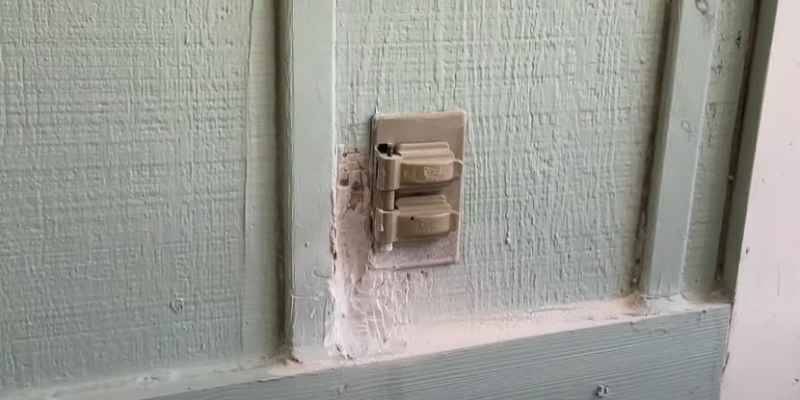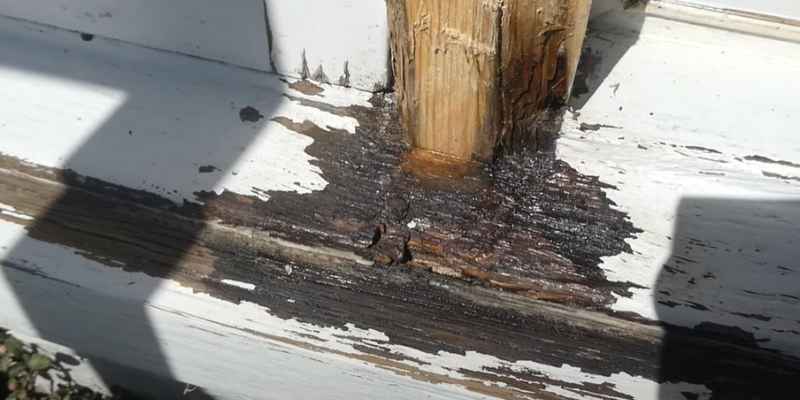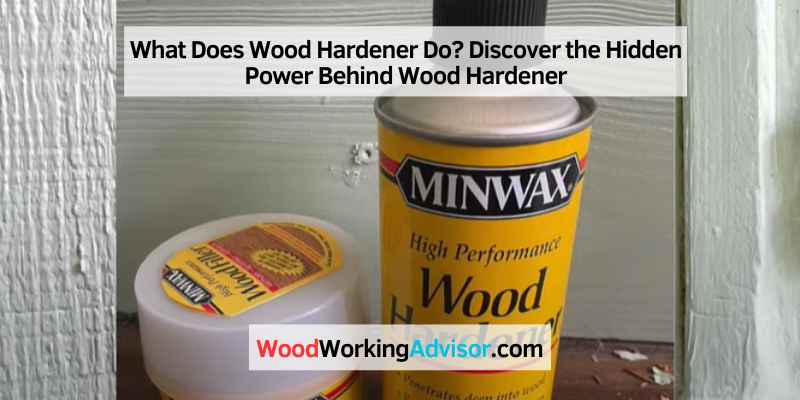Wood hardener is a product that strengthens and stabilizes damaged wood by penetrating deep into the fibers and bonding them together. Wood hardener is a powerful solution designed to fortify weakened wood by seeping into the pores and consolidating the fibers, making the structure more solid and durable.
Ideal for repairing rotted or cracked wood, this handy product enhances the strength and stability of wooden surfaces, preventing further damage and extending their lifespan. Whether you’re working on a woodworking project, restoring antique furniture, or fixing outdoor structures, using a wood hardener can help rejuvenate and reinforce the wood, making it strong and resilient once again.
As a cost-effective and practical solution, wood hardener offers a quick and efficient way to restore structural integrity to damaged wood, ensuring it can withstand everyday wear and tear.
The Science Of Wood Hardener
Wood hardener is a powerful solution that can work wonders on damaged or decaying wood. But have you ever wondered about the science behind how it actually works? In this section, we will delve into the fascinating world of wood hardeners and explore the chemical process that enables them to restore strength and durability to even the most weathered surfaces.
How Wood Hardener Works
To understand how wood hardener works, let’s start by taking a closer look at its key components. Wood hardeners are typically formulated with a combination of resins and solvents. These resins penetrate the wood fibers and bind them together, essentially creating a sturdy matrix that acts as a reinforcement. The solvents in the hardener help carry the resins deep into the wood, ensuring thorough penetration.
Once the wood hardener is applied to the damaged area, the resins begin to seep into the porous wood, filling any gaps or voids along the way. This process not only strengthens the affected wood but also prevents further deterioration by sealing off the area from moisture and other damaging elements. As the solvent evaporates, the resins solidify, creating a firm and durable surface.
Chemical Process Behind Wood Hardener
The chemical process behind wood hardeners involves polymerization, which is the reaction whereby smaller molecules join together to form larger molecules. The resins in the wood hardener undergo this polymerization process as they penetrate the wood fibers. The polymerization creates a cross-linking network, essentially strengthening and solidifying the wood from within.
Moreover, wood hardeners often contain catalysts that speed up the polymerization process. These catalysts act like a catalyst in a chemical reaction, accelerating the bonding of the resins and enhancing the overall hardening effect. As the catalysts work their magic, the resins quickly bind together, reinforcing the damaged wood and restoring its structural integrity.
It’s important to note that not all wood hardeners are created equal, and the specific chemical process may vary depending on the particular product. However, the fundamental principle remains the same – wood hardeners use resins and solvents to penetrate and strengthen damaged wood through the process of polymerization.

Benefits Of Using Wood Hardener
Wood hardener is a product that penetrates and strengthens damaged or rotted wood. It helps to restore the structural integrity of the wood, prevents further decay, and prepares the surface for filling and painting. Using wood hardener can extend the life of the wood, making it more durable and resistant to future damage.
Strengthens Wood Fibers
Using wood hardener has several benefits for restoring and preserving wood surfaces. One of the key advantages is that it strengthens the wood fibers, extending the life of your wooden structures and furniture. The hardener penetrates deep into the wood, binding loose or weak fibers together, and providing a solid foundation for your project. This enhanced strength contributes to the overall durability and stability of the wood, ensuring it can withstand years of use and environmental factors.
Repairs Rotten Or Damaged Wood
Another significant benefit of using wood hardener is its ability to repair rotten or damaged wood. Over time, exposure to moisture, insects, or age can cause wood to deteriorate, leaving it weak or completely rotten. With wood hardener, you can effectively halt further deterioration and restore the wood to its original strength and integrity. The hardener effectively fills in the gaps and holes caused by rot, reinforcing the wood and preventing further decay.
Using wood hardener is a cost-effective solution as it can help you salvage and restore damaged wood instead of expensive replacements. Whether you have a rotted wooden deck, window frames, or furniture, the hardener allows you to repair and restore them, saving both time and money.
In addition, the application process of a wood hardener is relatively straightforward. Simply apply the hardener to the damaged area, ensuring it penetrates deep into the fibers. Depending on the condition of the wood, additional applications may be required. Once the hardener has dried and cured, you can proceed with sanding, painting, or staining the wood, restoring its natural beauty.
Conclusion
By using a wood hardener, you can strengthen wood fibers and repair rotten or damaged wood effectively. This not only prolongs the life of your wooden structures and furniture but also saves you money by avoiding costly replacements. The hardener provides an excellent solution for both DIY enthusiasts and professionals looking to restore and preserve wooden surfaces. So, if you’re dealing with weak or rotted wood, consider using a wood hardener to bring back its strength and beauty.
Application And Techniques
Wood hardener is an essential product for restoring and preserving deteriorating wood. Proper application methods and the right tools and equipment are vital for achieving the best results. Understanding the correct application techniques is crucial for the successful use of wood hardener.
Proper Application Methods
When using a wood hardener, it’s important to apply the product evenly to the affected area. Start by cleaning the surface of the wood to remove dirt, debris, and loose particles. Use a brush or spray applicator to evenly coat the damaged wood with the wood hardener. Ensure that the hardener penetrates deeply into the wood fibers to provide maximum strength and stabilization. Let the treated wood dry completely before proceeding with any additional refinishing or repair work.
Tools And Equipment
Choosing the right tools and equipment for applying wood hardener is essential for achieving effective results. Some of the commonly used tools include brushes with natural bristles for applying the hardener evenly, spray applicators for larger surface areas, and protective gear such as gloves and masks to ensure safety during the application process. It’s important to select high-quality tools and equipment to ensure the proper and efficient application of wood hardener.
Safety Measures And Precautions
The use of wood hardener is a great way to strengthen and preserve damaged or decayed wood. However, it is important to prioritize safety measures and take necessary precautions while working with this product to ensure the well-being of individuals and the environment. By following these safety guidelines, you can confidently handle wood hardener and achieve optimal results.
Protective Gear
Wearing appropriate protective gear is essential when working with wood hardener. This includes:
- Safety glasses: Protect your eyes from potential splashes or fumes.
- Gloves: Prevent direct contact between the wood hardener and your skin.
- Respirator or mask: Filter out harmful vapors and avoid inhalation.
Ventilation And Environmental Considerations
Proper ventilation is vital to ensure a safe working environment. Here’s what you need to keep in mind:
- Avoid confined spaces: Work in a well-ventilated area or outdoors to minimize exposure to fumes.
- Keep windows and doors open: Allow fresh air to circulate, reducing the concentration of fumes.
- Use fans or exhaust systems: Enhance airflow and remove fumes effectively.
- Protect the surrounding environment: Cover nearby objects or surfaces to prevent accidental spills or stains.
By following these safety measures and taking necessary precautions, you can confidently work with wood hardener, ensuring the utmost safety for yourself and the environment. Let’s now dive into the step-by-step processof using wood hardener to rejuvenate your wood projects.

Common Wood Hardener Myths Debunked
Wood hardener is often underestimated and misunderstood by many people. In this section, we will debunk some common myths about wood hardener to provide you with a clearer understanding of its benefits and uses.
Myth 1: Wood Hardener Is Harmful To The Environment
Contrary to popular belief, wood hardener is not harmful to the environment. It is important to note that wood hardeners are specifically designed to penetrate and strengthen wood, rather than harming the surrounding environment in any way.
These products are typically water-based and low in VOCs (Volatile Organic Compounds), which means they do not release harmful chemicals into the air. They are also non-toxic and safe to use even in enclosed spaces.
In fact, using wood hardener can have environmental benefits. By strengthening and repairing damaged wood, it helps to prolong the life of the material. This reduces the need for frequent replacements or disposal of wood, thus contributing to overall sustainability.
Myth 2: Wood Hardener Is Only For Professionals
Another common misconception is that wood hardener is reserved solely for professionals. This is not true. While professionals may use wood hardener more frequently due to their line of work, it is equally accessible to DIY enthusiasts and homeowners.
Wood hardeners are available in various forms, including user-friendly spray cans or brush-on solutions. These products are designed with ease of use in mind, allowing anyone with basic woodworking skills to utilize them effectively.
Additionally, many brands provide clear instructions and guidelines on their packaging, making it easier for beginners to understand how to use wood hardener correctly. With some research and practice, even first-time users can achieve professional-level results.
It’s important to note that wood hardener should always be used in well-ventilated areas and with proper safety precautions, regardless of whether you are a professional or a beginner.
Frequently Asked Questions For What Does Wood Hardener Do
When Should You Use Wood Hardener?
Wood hardener should be used when you need to strengthen and repair damaged or rotten wood. It penetrates deep into the wood, creating a solid surface that can be easily painted or filled. Apply it to areas with splintering, cracking, or weak wood for optimal results
Does Wood Hardener Actually Work?
Yes, wood hardener does work effectively by penetrating deep into the wood and strengthening its structure, making it more durable. It also helps to prevent further decay or damage to the wood.
Does Wood Hardener Stop Rot?
Yes, wood hardener can stop rot by penetrating and strengthening the wood fibers, preventing further decay. It acts as a protective barrier against moisture and fungal growth. Wood hardener effectively stabilizes and restores rotted wood, extending its lifespan.
Does Wood Hardener Stabilize Wood?
Yes, wood hardener stabilizes wood by strengthening its fibers and preventing decay. It works by penetrating deep into the wood and bonding with its structure, making it stronger and more resistant to damage and rot.
Conclusion
Wood hardener is a versatile solution for treating and strengthening damaged wood. Its ability to penetrate and strengthen soft or rotted wood makes it a valuable tool for DIY enthusiasts and professionals alike. By understanding its application and benefits, you can effectively restore and preserve wooden surfaces for long-lasting durability.


